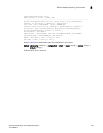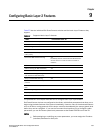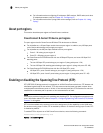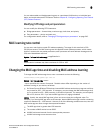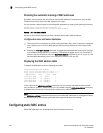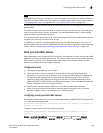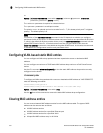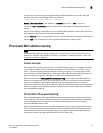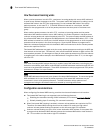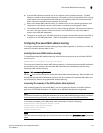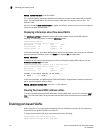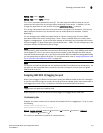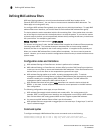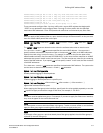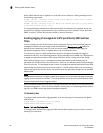
PowerConnect B-Series FCX Configuration Guide 311
53-1002266-01
Flow-based MAC address learning
9
For example, to remove entries for the MAC address 000d.cd80.00d0 in all VLANs, enter the
following command at the Privilege EXEC level of the CLI.
PowerConnect#clear mac-address 000d.cb80.00d0
Syntax: clear mac-address <mac-address> | ethernet <port-num> | vlan <vlan-num>
If you enter clear mac-address without any parameter, the software removes all MAC address
entries.
Use the <mac-address> parameter to remove a specific MAC address from all VLANs. Specify the
MAC address in the following format: HHHH.HHHH.HHHH.
Use the ethernet <port-num> parameter to remove all MAC addresses for a specific Ethernet port.
Use the vlan <num> parameter to remove all MAC addresses for a specific VLAN.
Flow-based MAC address learning
NOTE
Flow-based MAC address learning is supported on PowerConnect B-Series FCX Series devices.
However, on PowerConnect B-Series FCX Series , this feature is enabled by default. There is no
command to enable or disable it.
Feature overview
With regular MAC address learning, when a new MAC address is learned, it is programmed in the
same location (hardware index) in all packet processors in a PowerConnect Layer 2 or Layer 3
switch. There are multiple packet processors (one per port region) in a compact switch, and in
each module in a chassis-based switch. With regular MAC address learning, MAC addresses are
global, meaning the hardware MAC table is identical across all packet processors.
With the introduction of flow-based MAC address learning, when a new source MAC address is
learned, it is programmed only in the source packet processor (the processor that received the
packet). The destination MAC address gets added to other packet processors on demand,
whenever a traffic flow that needs it is detected. With flow-based MAC address learning, the MAC
address is programmed in different hardware locations and the hardware MAC table is different
across all packet processors.
The benefits of flow-based learning
With global MAC address learning, all MAC addresses are programmed in all packet processors,
even though they may not be required and are never used by all packet processors. Global MAC
address learning wastes some space in the hardware MAC table and limits the number of
supported MAC addresses to 16K.
With flow-based MAC address learning, MAC addresses are learned and programmed selectively,
only in the packet processors that need them. Since the MAC addresses are distributed across
several packet processors, flow-based learning frees up space in the hardware MAC table and
increases the number of supported MAC addresses from 16K to 32K.



